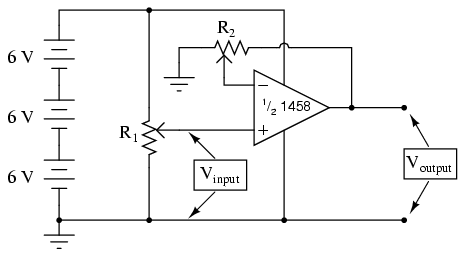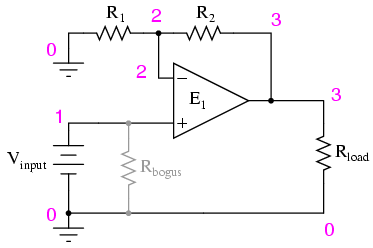Noninverting amplifier
PARTS AND MATERIALS
-
Operational amplifier, model 1458 or 353
recommended (Radio Shack catalog # 276-038 and 900-6298,
respectively)
-
Three 6 volt batteries
-
Two 10 kΩ potentiometers, linear taper
(Radio Shack catalog # 271-1715)
CROSS-REFERENCES
Lessons In Electric Circuits, Volume
3, chapter 8: "Operational Amplifiers"
LEARNING OBJECTIVES
SCHEMATIC DIAGRAM

ILLUSTRATION

INSTRUCTIONS
This circuit differs from the voltage
follower in only one respect: output voltage is "fed back"
to the inverting (-) input through a voltage-dividing
potentiometer rather than being directly connected. With
only a fraction of the output voltage fed back to the
inverting input, the op-amp will output a corresponding
multiple of the voltage sensed at the noninverting (+)
input in keeping the input differential voltage near zero.
In other words, the op-amp will now function as an amplifier
with a controllable voltage gain, that gain being
established by the position of the feedback potentiometer (R2).
Set R2 to approximately
mid-position. This should give a voltage gain of about 2.
Measure both input and output voltage for several positions
of the input potentiometer R1. Move R2
to a different position and re-take voltage measurements for
several positions of R1. For any given R2
position, the ratio between output and input voltage should
be the same.
You will also notice that the input and
output voltages are always positive with respect to ground.
Because the output voltage increases in a positive direction
for a positive increase of the input voltage, this amplifier
is referred to as noninverting. If the output and
input voltages were related to one another in an inverse
fashion (i.e. positive increasing input voltage results in
positive decreasing or negative increasing output), then the
amplifier would be known as an inverting type.
The ability to leverage an op-amp in this
fashion to create an amplifier with controllable voltage
gain makes this circuit an extremely useful one. It would
take quite a bit more design and troubleshooting effort to
produce a similar circuit using discrete transistors.
Try adjusting R2 for maximum and
minimum voltage gain. What is the lowest voltage gain
attainable with this amplifier configuration? Why do you
think this is?
COMPUTER SIMULATION
Schematic with SPICE node numbers:

Netlist (make a text file containing the
following text, verbatim):
Noninverting amplifier
vinput 1 0
r2 3 2 5k
r1 2 0 5k
rbogus 1 0 1meg
e1 3 0 1 2 999meg
rload 3 0 10k
.dc vinput 5 5 1
.print dc v(1,0) v(3,0)
.end
With R1 and R2 set
equally to 5 kΩ in the simulation, it mimics the feedback
potentiometer of the real circuit at mid-position (50%). To
simulate the potentiometer at the 75% position, set R2
to 7.5 kΩ and R1 to 2.5 kΩ. |